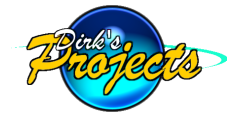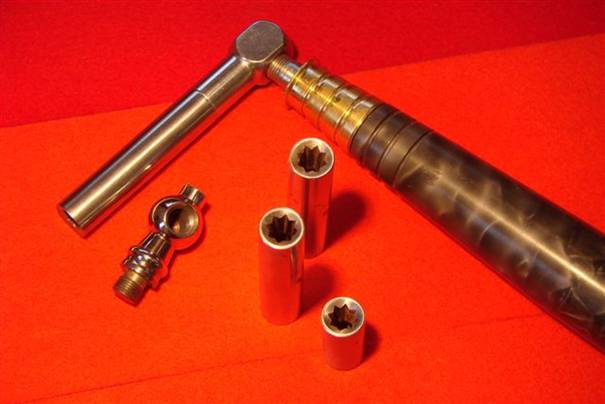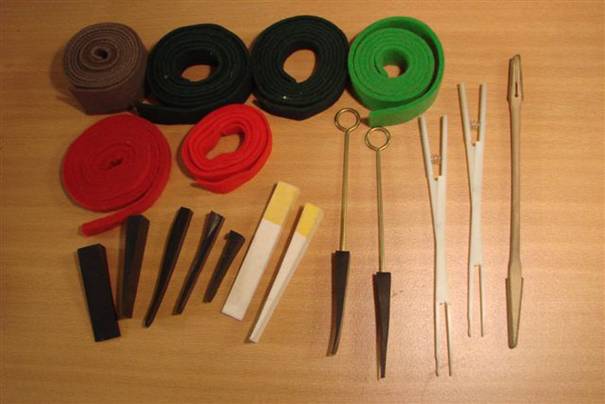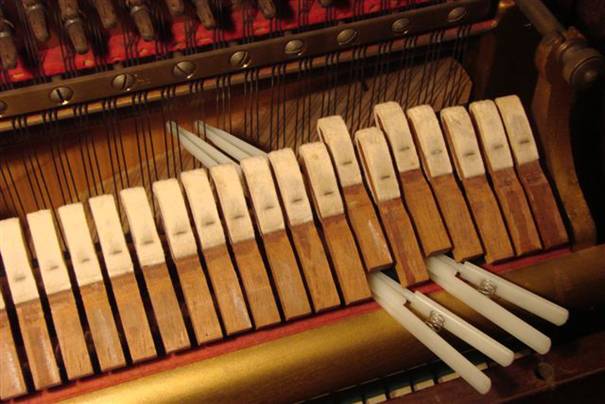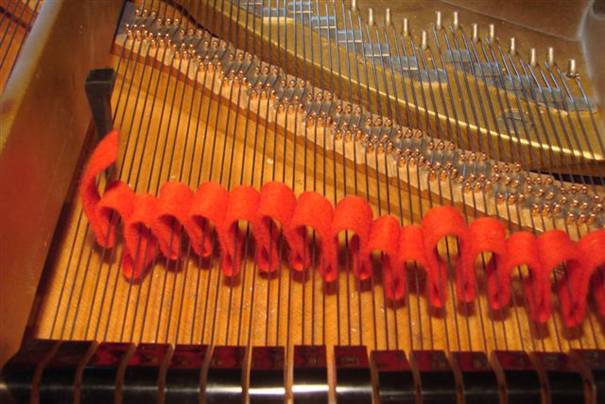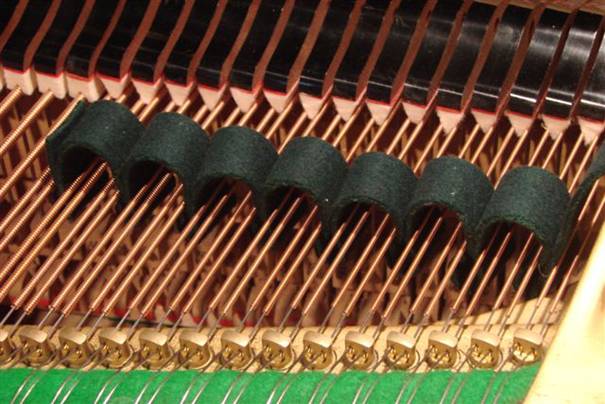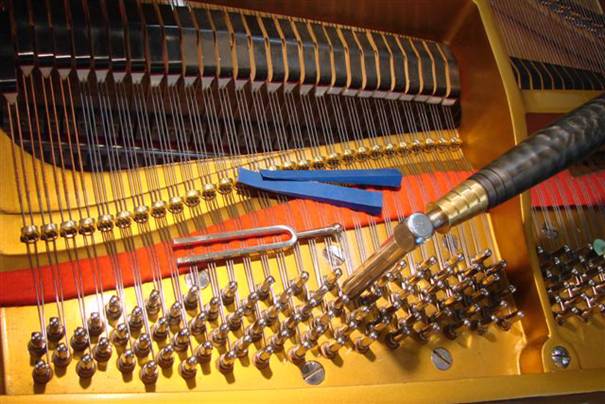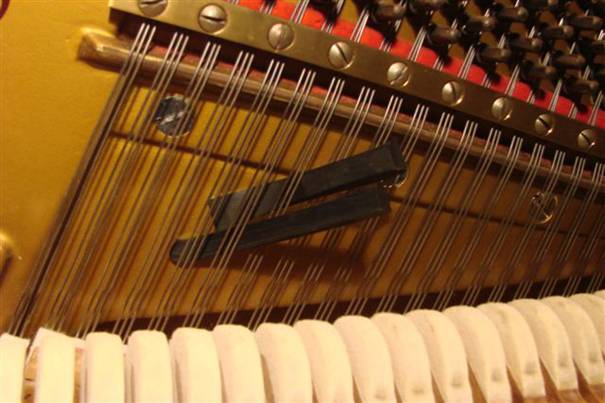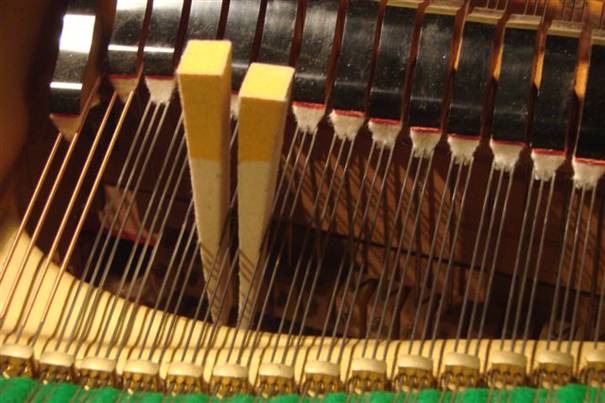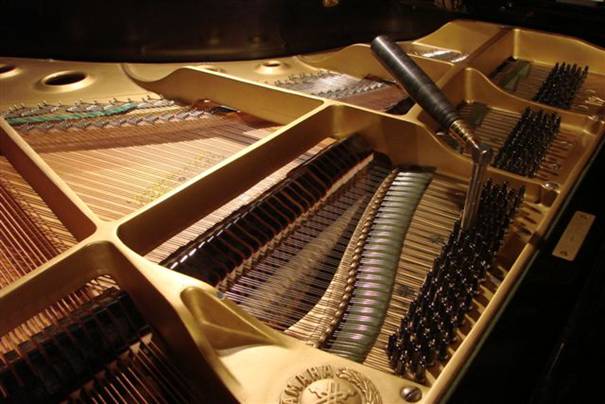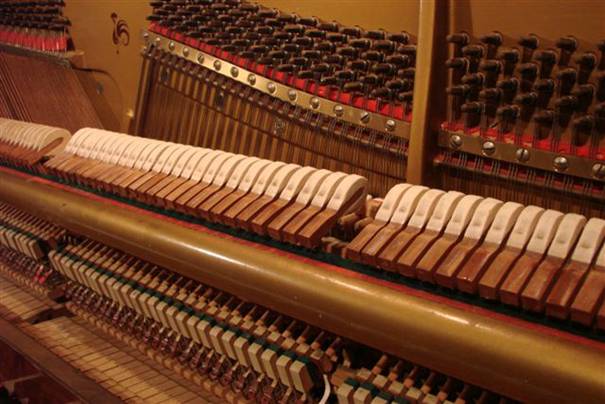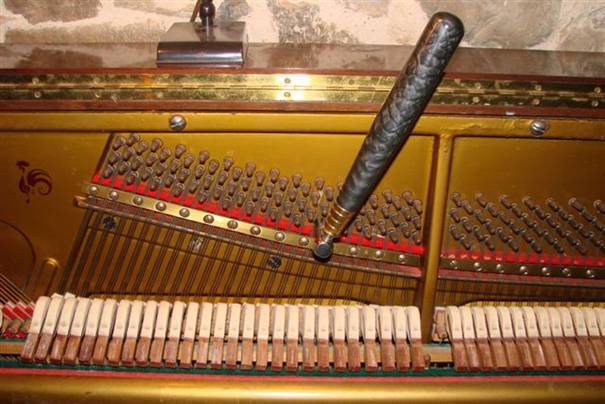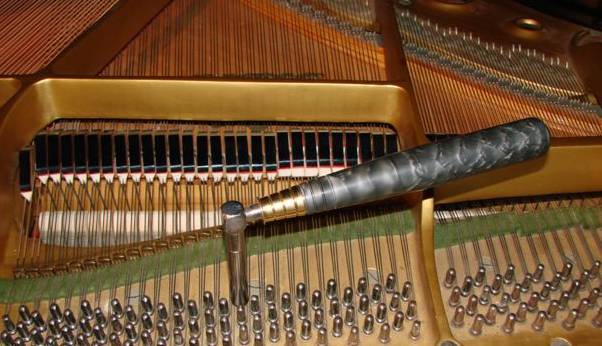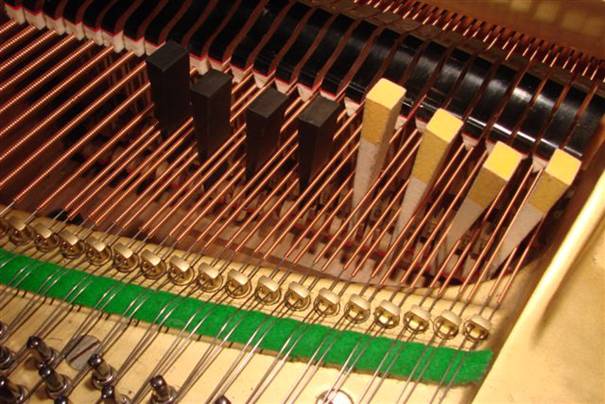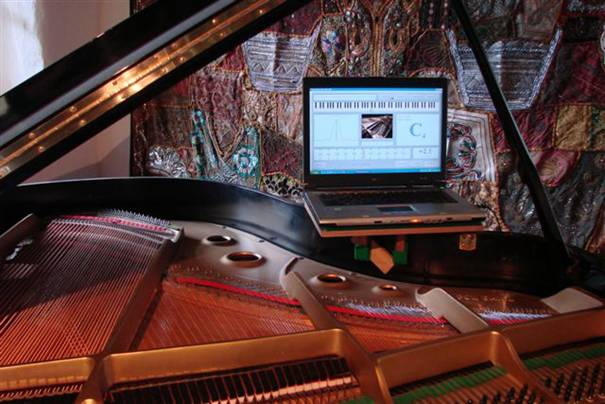Introduction
In this short manual we would like to try to help people, who have little to no experience with piano tuning, on their way to start tuning. We strongly advice you to read this whole manual, so you will know what tuning is all about, before you start tuning your valuable instrument.
You must realize that tuning isn't something you learn in a heartbeat. It takes a certain dose of perseverance and self-criticism to learn to tune a piano to a reasonable level.
Many tuners using Dirk's Piano Tuner are reaching a level of tuning they thought unreachable.
Some knowledge about the great varieties of upright pianos and grand pianos and their technology with all its details may be useful too. You should be able to recognize any deviations and occurring "side effects" and be able to solve them if needed.
Dirk's Piano Tuner
Tune a piano yourself to a professional standard
Compatibility
Microsoft

- Desktop
- Laptop
- Netbook
- Tablet
- Phone
- Pocket PC
- Windows 11
- Windows 10
- Windows 8.1
- Windows 8
- Windows 7
- Windows Vista
- Windows XP
- Windows ME
- Windows 2000
- Windows 98
- Windows Phone
- Windows RT
Apple

- iMac
- Mac Pro
- Mac mini
- MacBook
- Intel cpu
- Apple M-Chips
- iPad
- iPhone
- Sequoia
- Sonoma
- Ventura
- Monterey
- Big Sur
- Catalina
- Mojave
- High Sierra
- Sierra
- El Capitan
- Yosemite
- Mavericks
- Mountain Lion
- Lion
- Snow Leopard
- Leopard
- Tiger
- iOS iPhone
- iOS iPad
The tuner is available in the following languages:
The Tuning Hammer
Now about tuning in practice. First some imperative tools for piano tuning:
You can turn the tuning pins with this "lever". More about this "turning" later on. Buy a good Tuning Hammer, because a good Tuning Hammer gives you more feeling and better control during tuning. The Hammer shouldn't be too light or too long. The stiffer (less flexible) the Tuning Hammer is, the better the feeling with the tuning pins is. The "head" must be star-shaped to fit the square tuning pins. There are different sizes of tuning pins, so make sure you buy the right size Tuning Hammer for your tuning pins.
The star-shape gives you the possibility to put your Tuning Hammer in different positions on your tuning pins. This way you can always put the hammer in the most suitable position.
A Tuning Hammer with exchangeable head is recommended, when you are planning to tune more than one piano. You can put different heads with different sizes and lengths on this hammer suitable for any kind of tuning pin. A dealer can give you good advice about this.
Mutes, Tweezers and Felt Strips
These tools are used to mute strings that aren't supposed to be heard during tuning. You'll need some rubber Mutes for muting strings. Some Mutes with a metal wire handle are recommendable too. Especially for instruments were there isn't enough space everywhere for the normal Mutes.
Plastic reverse operating Tweezers are available for use in upright pianos. Those Tweezers must be (gently!) maneuvered between the hammer shafts. They are used to mute two adjacent strings or the two outer strings of a unison so you can tune the inner string. A unison is a set of three (middle section and treble side) or two bass strings that are equally tuned and that belong to one tone.
These Tweezers are especially used on the treble side (highest notes, shortest strings) of the piano, where there is no room for the normal Mutes. So these keys activate a hammer that hits two or three equally tuned strings.
There are also flexible Felt Strips in different thicknesses available. These Strips are mostly used in grand pianos. You can loop these Strips around all (left and right) outer strings of a unison to mute those strings, so only inner strings will sound. Some people prefer this method above the Mutes, because they say it works faster.
With the dual string unisons you always skip one space so you can alternately tune a left and a right string of the successive tones.
It is recommendable to use a flat aluminum or wooden tool when applying these Strips. Make sure not to hit the soundboard with this tool, because you might damage the soundboard. It is also very important to press the sustain pedal (the pedal which allows you to lift all dampers lightly at once) down to prevent damage or deformation of the damper felts by the lateral movements of the strings. Be sure to press the sustain pedal down again when you want to remove the Strip. Put your flat hand on the strings (be sure to wear gloves to prevent oxidation of the strings) while removing the Strip so you won't cause big movements of the strings, which could lead to damage to the dampers. Uncontrolled actions could also lead to the detuning of your instrument.
Turning the Tuning Pins
One thing is important with turning the pins: minimal movement, sometimes you can't speak of turning at all. First you've got to find out if you need to increase or decrease the pitch. When you start tuning it is saver to tune your string downward a little to prevent that you tune your string to tight, which can lead to overstretching of your string which in turn can lead to deformation or breaking of the string. Practicing these minimal movements is essential for developing a good feeling. A good feeling is essential for a good tuning result. We advice you to practice this before moving on to tuning the piano.
Begin with muting some outer strings of some unisons with Mutes. Don't do anything with the inner strings and place the Tune Hammer on the Tuning Pin of an outer string that isn't muted.
Try to put a little bit of pressure on the Tuning Hammer, to the left because you want to decrease the pitch, but without turning the pin. Listen carefully at what you hear. Increase the pressure on the Tuning Hammer a little bit, when you don't hear a difference. Increase the pressure until you start hearing beats. When you start hearing beats it means that there is now pitch difference between the inner string and the outer string. The larger the difference, the faster the beat. When you let go of the Tuning Hammer now (and you didn't turn the Pin), the Pin will return to its former position and the pitch difference will disappear because of this. This is of great importance to the tuning later on. What did happen here? All you can see of the Tuning Pin is only half of the actual Pin. The invisible part of it is clamped into the pin block and keeps it real tightly clamped which prevents that the string can relax itself.
Putting just a little bit of pressure on the Tuning Hammer makes the Tuning Pin twist a little. This flexibility is "just" a property of the material. The material is to some extend "elastic" even though it's made of quality steel. At the place where the Pin is clamped into the pin block, there is so much resistance, that the Pins won't always return to their former position, when you turn them. It's your duty during tuning to help the Pins with this, because otherwise the strings will do this for you when you play the piano and this will lead to detuning of the piano. This process is called setting the pins and is vital for a stable tuning. You must therefore ensure that the pins will stand in a clear rest position, so you can contribute to this stable tuning. This is one of the hardest parts of tuning! You can check this by hitting the key harder a couple of times and listen if there are changes or not.
Tuning Stability
This takes us to the point of the Tuning Stability: When you look at the total length of the string in the piano, you will discover that you can divide the string into three sections. The first part, starting from the tuning pin, is the section of the string that doesn't vibrate. That section of the string runs over a fixed point that may be implemented in different ways depending on the location and the type of instrument. Those fixed points are the agraffes and the capo (if any). The second section of the string is the so called free vibrating section of the string. The hammer head hits this section of the string. It's the sounding part of the string. This section of the string runs over the bridge, which is attached to the soundboard. The first fixed point (seen from the tuning pin) up to the bridge determines the sounding section of the string. The bridge is the second fixed point that the string runs over. The third section of the string is a (second) non-vibrating section of the string. It runs from the bridge to the end of the string and its attachment point, the so called string pegs.
But we were still talking about Tuning Stability. You can imagine that a relatively high resistance exists on the two fixed points, where the string "shifts" over during tuning (or when changing the string tension), partly because of the high string tension. That resistance can lead to tension differences between the three sections of the string. If you let this difference exist, it will level out while playing the piano and that will fairly quickly detune the piano. Hitting the key several times hard will make sure that the tensions in the three sections of the string become equal.
It is recommended to tune the pitch a little bit higher first and then tune down to the preferred pitch while hitting the key repeatedly. Hitting the key will help the string run over the fixed points easier. By tuning the pitch a little higher, the string tension will help reaching the right pitch.
You'll have to develop the ability to get the tuning pin into a clear rest position, to eliminate string tension differences and to finally reach the right pitch.
Turning the Tuning Pins
Now something about what happens, when we do have to turn the tuning pins. The tuning pins are clamped into the pinblock. The pins are pretty stuck in the block. You'll have to overcome a lot of resistance to get the pin to turn around. The tension of the string will help you, when you want to tune the pitch of the string down. When you want to tune the pitch higher you'll have to overcome the resistance of the pins and also the tension of the string. How do we tune higher or lower? There is a difference between the grand piano and the upright piano on this matter. We'll tell you about it below.
First the upright piano. Take a good look at the tuning pin and the way the string is attached to the pin. The string leaves the tuning pin and goes down to the bottom of the piano, to the left. You'll have to understand that turning the pin left will lower the string tension and will also lower the pitch. Turning to the right will have the opposite effect and will make the pitch go up.
What about the grand piano? Well it is not very different from the upright piano, but you'll have to notice the differences to make no mistakes while tuning.
The string leaves the pin on the right side of the pin and runs to the "tail" of the grand piano (when we look from keyboard to tail).
You'll have to understand that the pitch/string tension will get higher when you turn the tuning pin to the right. Turning left will make everything go down. It is important that you respect the structural differences between a grand and an upright, because the way the Tuning Hammer is placed and moved is very different with grand pianos or upright pianos.
With an upright piano it is best to place the handle of the Tuning Hammer in an upright position a little to the right of a vertical line.
Looking at clock time place the Hammer at about 1 o'clock. Turn the Tuning Hammer to the right to make the pitch go up.
With the grand piano place the handle of the Tuning Hammer to the right and slightly away from you. Seen from above it stands at about two o'clock.
Pull the Tuning Hammer towards yourself to get the pitch to go up.
The motion of the pin
We'll still have to explain one of the most important parts of tuning to complete this explanation: The motion of the pin and which pin we have to turn.
You will notice that there is a lot of difference in the feeling between turning pins. You will notice this in one and the same piano too. Sometimes the pins are very smooth and accurately turnable, but often turning will go choppy. Those pins are known for "jumping" ( too far), when you try to apply a little more strength on the Tuning Hammer. Don't be scared of the "screeching" noises that will occur with this. These noises are caused by the "wringing" of the tuning pin in the pin block and won't cause any damage. Again teach yourself the skill to turn a tuning pin with very small movements under all circumstances. This is of utmost importance. If you master this, you will not only prevent the string from overstretching, but you will also be able to tune a string very precisely. The differences in pitch you'll have to adjust will often be extremely small.
First check very well if you have the right Tuning Pin for the string you want to tune, before you start tuning. Follow the string until you are really sure you have the right tuning pin.
When you start turning the pin and the pitch doesn't change directly, don't keep turning, because there is a chance you are turning the wrong pin. It is safer to put a little pressure on the Tuning Hammer without turning the pin. You should notice that the pitch will go up a little while doing this. If it doesn't you can be sure you are touching the wrong pin and you have muted the wrong string. Always check this before you start turning the pin maybe causing unpleasant consequences for the string.
For that same (safety) reason it is preferred to first tune a little lower and then go up. Again: it's recommended to tune the pitch a little bit higher first and then tune the pitch down to the right pitch, because of the stability of the tuning we want to reach. With this you will achieve that the "turning" of the tuning pin will lift itself and you will be able to neutralize the tension differences in the string easier. Make absolutely sure the tuning pin will reach its rest position! In the beginning it will look like a chaotic state with all the pins, but when you study the pins a little better you will discover a clear logical pattern in the pins. Later it will be much easier to find the right pin, but it's better to make sure you have the right pin a few times too often than adjusting something without checking.
Raising the pitch
Earlier on we mentioned the very high string tensions: this can amount to an average of about 80 kilograms per string, which results in a total force of about 18000 kilograms on the instrument (the frame).
Imagine you start tuning on a piano of which the pitch of the whole range is much too low. You can imagine that it's, purely in terms of the proportional distribution of the pulling forces, important that you bring up these forces as evenly as possible over the piano.
It's also important to know that you'll have to adjust pitch deviations of more than 30 cents in multiple steps because of the above reason (look for more about cent deviations in the relevant paragraph of the manual). In such a case, first perform a "rough" tuning with the sole purpose of bringing the pitch closer to the desired pitch while trying to reach an evenly as possible divided tension in the instrument. Such a rough tuning can be reached within 15 to 20 minutes after some experience and it's not important that there are still some little beatings hearable in the unisons on that moment.
We will show you a method to achieve that uniformity now:
- First start tuning the middle strings of the octaves between C3 and C5
- Second tune one of the strings of each unison of the double bass section
- Third tune every middle strings from C5 up to C8
- Fourth tune the lower single bass strings
- Fifth tune every left string of all unisons from C3 up to C8
- Sixth tune every remaining string of the double bass section
- Last tune all right strings from C3 up to C8
Note that the transition between double bass strings and the triple unisons isn't the same in all instruments at C3. You'll have to check this and adjust when needed.
Disclaimer
Although we tried to explain the tuning procedure very carefully, any damage from any cause whatsoever will be outside our liability because it's simply impossible to teach you, within this brief manual and without any practical experience, all the facets of this wonderful profession.
All we can advice is: practice a lot and listen to what you are doing. Also without the Tuning Device. Then it won't be only about the tuning, but purely about a better understanding of everything and about developing the skills of manipulating the Tuning Hammer.
We wish you every success and hope you'll be able to enjoy a beautiful tuning result soon.


